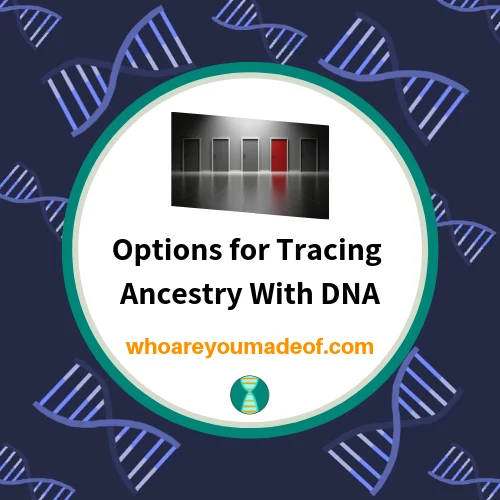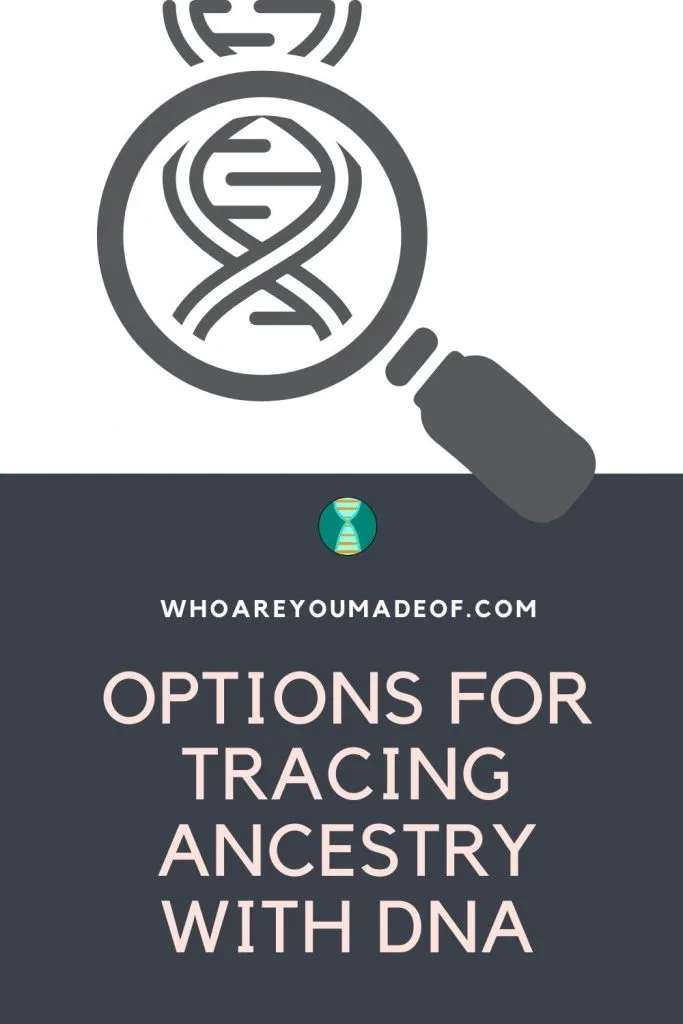If you have heard that you can use your DNA to help learn about your roots, you heard correctly. Whether you are searching for living biological relatives, or are interested in learning about the ancient origins of your paternal line's surname, your DNA can help. In this post, I'll explain the ways that you can use your DNA to trace your roots.
This post will help you understand:
- The different types of DNA testing available
- The type of information that you can learn with the various available DNA tests
- Which companies offer the different tests, and how to choose between them

Which types of DNA tests can help you learn about your ancestry?
There are three main types of DNA tests that you can take to learn about your ancestry. Each type of DNA test analyzes different parts of your DNA.
The three main types of DNA tests for ancestry are:
- Autosomal DNA tests
- Y-DNA tests
- mtDNA tests
Of these three tests, autosomal DNA testing is by far the most popular. Even so, the other two DNA tests can provide you with important information about your roots. Below, I'll discuss the exact information that you can learn from each of these three types of tests.
What can you learn from the different types of DNA tests?
Because each test tests different DNA, the information that you can learn from each type of test is different. For example, the DNA test that provides you with a pie chart and percentages describing where your ancestors may have lived is not the same DNA test that can help you discover the origins of your direct maternal line.
What can you learn from an autosomal DNA test?
Autosomal DNA tests analyze your autosomal DNA, inherited from both of your parents. Every person inherits 50% of their DNA from each of their parents, and every parent passes down 50% of their DNA to each of their children.
This DNA inheritance pattern means that autosomal DNA tests are best for estimating where our ancestors may have lived over the past several hundred years.
Autosomal tests can provide you with:
- Your ancestral origins. In other words, which part of the world did ancestors come from? This is the "ethnicity estimate" or ancestry composition" report, and is the most popular reason for doing DNA testing.
- A list of DNA matches or DNA relatives. This is basically a list of people who tested their DNA with the same company that you did, and who share genetic material with you. This is a great way to find living family members who tested their DNA on the same site.
Uses for autosomal DNA results
Most people use their autosomal DNA results to learn about their ancestral origins, discover biological family, or build their family tree.
What can you learn from a Y-DNA test?
First, it is important to know that only males can take a Y-DNA test. While it might sound unfair, it's only because we women don't have a Y chromosome to test.
Y-DNA tests analyze Y-DNA, which males inherit their Y-DNA from their father. These tests can tell us general information about our paternal lines going back tens of thousands of years.
From Y-DNA tests, we can learn:
- The ancient origins of our direct paternal lines. Our direct paternal line is our father's father's father's father's father's (etc) line.
- The likely migration path that our direct paternal ancestors took thousands of years ago - even as far back as to Africa!
- Y-DNA matches that share the same Y-DNA haplogroup
- Sensitive tests that include more Y-DNA sub-clades can detect more recent mutations in Y-DNA and thus provide closer Y-DNA matches
Uses for Y-DNA results
People use Y-DNA to trace their paternal surname through history, verify the male lines of their family tree, discover relatives who share the same Y-DNA haplogroups and subclades, use information learned to add lines to family tree, participate in surname research projects, and more.
Can women get Y-DNA results?
If you are a woman and would like to learn more about your father's direct paternal line, you have some options. The easiest option, if available, is to have your father or a male sibling who shares the same father with you take a Y-DNA test.
Alternatively, a male uncle who shares the same father with your dad, or a male first cousin who is descended from a male uncle (who also shares your father's father), would have the same Y-DNA as your father.
What can you learn from a mtDNA test?
Both men and women have mitochondrial DNA (mtDNA) and so both men and women can take mtDNA tests to learn about their direct maternal line. Mitochondrial DNA is inherited from our mothers and is contained in almost every cell in our body.
Our direct maternal line includes the pure maternal ancestors of our mother's mother's mother's mother's mother's (etc...) mother.
We can learn the following information from a mtDNA test:
- Ancient origins of our direct maternal lines going back as far as tens of thousands of years
- The migration pattern of our direct maternal ancestors back many thousands of years ago
- DNA matches that share the same maternal (mtDNA) haplogroup and sub-clades
Uses for mtDNA results
Similar to Y-DNA results, mtDNA results can be used to disprove genealogical theories. For example, two descendants of the same direct-line female ancestor should share the same mtDNA haplogroup.
If they don't, then more research needs to be done to see where the genealogical research is incorrect. Sensitive mtDNA tests can also provide genetic matching for mtDNA haplogroups, which can occasionally be used to learn about descendants of direct maternal ancestors.
Which are the best companies offering DNA testing?
Now that you know about the main types of DNA testing for ancestry, you probably have a good idea as to which test you are interested in. I have recommendations for these companies that I have used personally and have had good results with.
Recommendations for autosomal DNA testing
The best companies for autosomal DNA testing are Ancestry DNA, 23andMe, MyHeritage DNA, Family Tree DNA, and Living DNA. Of these, Ancestry DNA and 23andMe are my current favorites, though each of these companies offers a quality test.
You can order a DNA test using any of the links below. I may receive a very small commission that helps me support this site, and it is at no extra cost to you, so thank you!
Recommendations for Y-DNA and mtDNA testing
Conclusion
I hope that this post has helped you understand more about how to use DNA testing to learn about your ancestry, and how to choose the best DNA test to help you meet your research goal. If you have any questions about something that you read in this post, or if you would like to share your own experience using DNA to learn about your heritage, please feel to join us in the discussion below.
Thanks for being here today!


